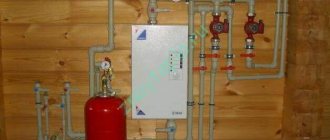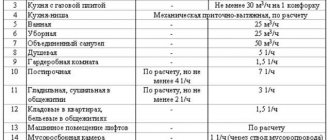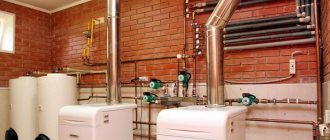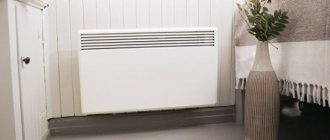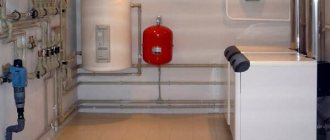Popular home heating with electric convectors cannot be called economical, like all devices that use network resources. However, it deserves the attention of private home owners as an alternative to gas mains, the installation of which requires compliance with many aspects.
In addition, not all regions of Russia can provide such a service, in the absence of a gas pipeline at all. The advantages and disadvantages of this type of heater and ways to save money when using these systems are described below.
Electric heater power calculation
There are two ways to calculate the power of the device.
By room area
It should be borne in mind that calculating the power of a heating unit by area gives approximate indicators and requires corrections. But it is simple and can be used for quick, approximate calculations. So, based on the established standards, for a room with one door, one window and a wall height of 2.5 meters, a power of 0.1 kW/h per 1 m2 of area is required.
For example, if we take a room with an area of 10 m2 for calculation, then the required power of the unit will be equal to 10 * 0.1 = 1 kW. But it is worth considering some factors. In the case of a corner room, the correction factor will be 1.1. The result found should be multiplied by this number. Provided that the room has good thermal insulation and has plastic (energy-saving) windows installed, the calculation result should be multiplied by 0.8.
By volume
To calculate the power of a heating convector by volume, you need:
- calculate the volume of the room (width*length*height);
- the found number must be multiplied by 0.04 (exactly 0.04 kW of heat is needed to warm up 1 m3 of room);
- Using coefficients, clarify the result.
Due to the fact that the height of the room is also used in the calculation, the power calculation will be more accurate. For example, if the volume of the room is 30 m3 (area 10 m2, ceiling height 3 m), then 30 * 0.04 = 1.2 kW. It turns out that for this room you will need a heater with approximately a power slightly higher than that found.
For a more accurate result, power should be calculated using a coefficient. If there is more than one window in the room, then for each next one, 10% is added to the result. This figure can be reduced if the walls (floors in a private house) are well insulated.
As an additional source of heating
If the main heating is not enough during severe frosts, then an electric convector is often used as an additional source of thermal energy. The calculation, in this case, is made as follows:
- when calculating the indicator by area, 30-50 W are required for each square meter;
- when calculating by volume, 0.015-0.02 kW is required per 1 m3.
Tips for selection and operation
When planning to purchase an electric convector for a country house, you should pay attention to important parameters
- Device power. It depends on the area of the room. On average, 1 m2 should account for 100 W of consumed electricity. If the facility is poorly insulated, energy costs will be 50% higher.
- Placement method. Wall-mounted modules are installed in living rooms, while floor-mounted mobile options are used to heat auxiliary rooms. If the convector is the only source of heat, it is mounted on the wall, under the window, like a regular heating radiator. In-floor models are convenient and do not take up free space, but their installation is carried out during the construction stage.
- Object type. It is better to equip corner rooms or spaces with large window openings with several low-power convectors, evenly distributing them throughout the interior of the house.
- Heating device status. If we are talking about the auxiliary use of a convector in combination with water or air heating from a boiler or stove, you can take a device that is 40-60% less powerful than for a completely autonomous application.
- Type of heating element. Monolithic options - all-metal, with a common frame and frequent comb gratings are considered the most reliable. Options with heating elements are cheaper, tubular elements give off heat well, but when heated they crack slightly and do not withstand shock loads well. Needle heating elements are included in the cheapest models; their value as convectors is low.
- Type of thermostat. The mechanical version is the simplest, works with step switching and a special relay, and has an error of up to 3 degrees. These types of control units are reliable and can more easily withstand voltage surges and temporary power outages. An electronic thermostat is more accurate and advanced; it allows you to adjust temperature conditions, automate heating, reducing heat production during certain periods. In a country house, a simple option with a mechanical thermostat will be more reliable.
- Device safety level. Equipment may have built-in moisture protection - such models are suitable for bathrooms and kitchens. In addition, the device must have level 2 protection against electric shock. Floor-standing equipment can be equipped with a special sensor that de-energizes it when the device is tipped over.
During operation of the device, the owner will benefit from options that help make its use more efficient. Modern convectors can be controlled from a remote control. In addition, among the options, the function of air ozonation and restart, which reproduces the last used mode, will be useful. Models with electronic control are capable of automatically turning on when the room temperature drops below +5 degrees, maintaining the set values in the “anti-freeze” mode.
For a wooden country house with minimal thermal insulation, the efforts of a convector may not be enough. But in a room with stone or brick walls, without drafts and significant heat losses, such a device will give good results.
To learn how to choose an electric convector, see the video below.
Useful additional features
When choosing electric heating convectors, pay attention not only to technical parameters. There are also additional functions that increase comfort and safety:
- Overheat protection. An additional sensor is installed on the case, which turns off the power when a threshold value is reached. Usually it is +60°C.
- Drop shutdown. This function is relevant for models with floor-mounted installation. If the position changes (falls or bends too much), the power turns off. This function prevents possible fires.
- Restart. When turned on again, the electric convector automatically sets the settings that were when it was turned off.

Skirting-type convector - very low and long
Overheat protection and drop shutdown are very useful features that increase the safety of the equipment. Something else you can pay attention to is how quiet or loud the unit is. It's not just the heating element (it usually clicks). When activated, the mechanical thermostat also clicks. When choosing convection heaters for your bedroom, quiet operation is very important.
Useful tips
The smaller the volume of coolant in the heating system of a private house, the more efficiently the electrode-type boiler operates. Therefore, it is recommended to use bimetallic or aluminum radiators and contour wiring made of polyethylene pipes to construct the heating system.
Please note that it is best to create your own new heating for an electrode heating unit. It is not worth embedding it into an old one, where another type of heating device was used.
Thermal insulation and connection
Experts recommend thermal insulation of all circuits. The connection is best done with a separate cable from the distribution panel with the installation of a separate machine. An RCD (residual current device) cannot be installed in the electrical connection circuit.
The installation must be grounded, as is the case with other models of electric heating units.
Increasing heating efficiency
If the power of one boiler is not enough to heat a large house, then several devices can be installed in a single system. They can be connected to each other in parallel or in series.
And one last thing. Heating boilers of this type are installed only in a closed system where a circulation pump is installed. The latter provides additional coolant resistance, which affects the quality of heat generation.
Electric heating systems
Of course, the very concept of “electric heating systems” includes quite a lot of different types of devices. But in fact, it implies two radically different heating systems:
- system with circulating coolant. Such a system is very expensive because it requires a lot of equipment - a heating boiler, a circulation pump, an expansion tank. In addition, you will have to spend money on radiators and pipes.
- heating using electrical appliances. That is, using fan heaters, colorizers, convectors.
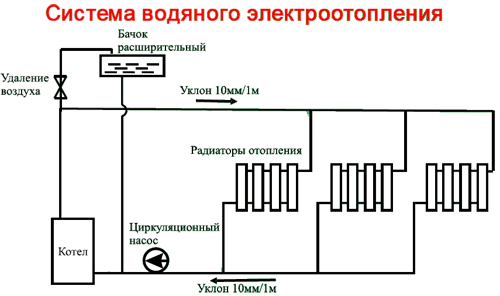
Heating system with electric boiler
Application of solar energy
We warm the water with the sun. What does this look like in practice?
- If the system is based only on solar energy, then a solar collector for heating and water heating will be responsible for delivering heat to the apartment. An option using a panel battery is also possible.
- In summer, solar energy is not at all useless, because it can be used to heat greenhouses or a swimming pool.
- When choosing a hybrid, heating will be provided not only by solar energy, but also by geothermal pumps. This option is preferable for places where the number of partly cloudy days in winter is limited.
- The geothermal circuit in a hybrid system will act as a thermal accumulator, storing heat that is consumed later if necessary.

Manufacturers
Among the convectors that are most popular among owners of country houses and country houses, models from well-known European and Asian brands attract the most attention. Let's consider which manufacturers deserve the most trust
Ballu
The well-known Asian brand is based in China, Japan and Korea, and has its own factories in Russia and EU countries. The company produces a wide range of products in the budget and mid-price segments. The company's products are dominated by simple and reliable models equipped with an electronic or mechanical thermostat. Of particular interest is the Transformer System series produced in the Russian Federation, installed in floor and wall versions, equipped with one of three types of control unit.
Among the popular models are the Enzo Bec/EZMR-2000 convector on comfortable wheels, with a mechanical thermostat, Ettore BEC/ETER-2000 with an electronic thermostat and a built-in air ionizer, Auto Restart system in case of a power outage. In total, the product line includes several dozen models, differing in power and technical equipment.
NeoClima
A well-known Greek brand that produces hanging and floor-mounted convectors in an affordable price category. Among the popular models we can highlight Comforte 1.5 with two heating modes - 0.75 and 1.5 kW. The equipment is equipped with a mechanical thermostat, wall mounted, and equipped with automatic protection against freezing and overheating.
Electrolux
A well-known European manufacturer offers electric convectors that are excellent in performance and design. The company's products belong to the premium class and allow heating country houses of various sizes, ensuring full automation of all processes. Among the popular models is the suspended version ECH/AG2-1500 T, designed to heat rooms up to 20 m2 and equipped with an electronic control unit.
Hyundai
The well-known Korean brand produces mainly floor-standing models of equipment. For a country house, the manufacturer offers the H-HV15-10-UI617 model, designed for an area of 10-15 m2. The device has a power of 1 kW, does not create a large load on the network, is equipped with a simple mechanical thermostat and stable legs.
We calculate the number of convectors

By placing appliances under windows, you prevent cold air from entering from them.
Are you planning to buy convectors for heating your home, but can’t figure out how many there are? In many cases, one heater is enough to heat one room. For example, for a room of 15 square meters. m in a well-insulated house, you should purchase a model with a power of 1000 W (as manufacturers advise, but we remember the need for a reserve and the climatic conditions of our country). Therefore, the recommended power will be 1500 W.
The optimal place to place a convector is under a window from which the cold comes . In order to protect yourself from the cold, we place devices under the windows. Accordingly, if there are three windows in a given room, we hang a heating device under each. In total, we will need three electric convectors with a power of 500 W each. The area of the room is 25 square meters. m, but it only has two windows? In this case, two convectors with a power of 1 and 1.5 kW are required.
To heat large rooms more uniformly, you can increase the number of convectors by reducing their power - for example, in a room of 25 square meters. m, you can place two 1 kW convectors under the windows, and a third heater can be placed on one of the walls.
The best electric floor convectors
Floor-standing models are installed directly on the floor surface. Such convectors are suitable for houses with panoramic windows or rooms where there is no possibility of wall mounting. The devices are distinguished by their small size, safety and high power, so they often consume a lot of electricity. This category also features four nominees who took their positions in the TOP due to their quality.
Resanta OK-2500
The silent, economical Resanta convector quickly heats an area of up to 25 sq/m. The main heating element is a heating element located in the lower part of the housing. Thanks to the ventilation holes at the bottom and top, it evenly heats the air and allows it to circulate freely inside the convector. Also included is a wall mounting bracket and stable wide legs with removable casters. The cord of the device is quite long and strong, the plug fits Euro sockets, which users consider an advantage of the model.
Advantages
- X-shaped heating element;
- Operation indicator;
- Overheat shutdown;
- Protection from moisture and voltage surges;
- Light weight.
Flaws
- Thin metal;
- Strong heating of the rear wall.
Buyers are not advised to place Resanta directly on the wall, since the back wall of the device gets quite hot.
Hyundai H-HV15-10-UI617
A small compact convector from Hyundai is designed for a small room. Its power is only 1000 W, but it heats up the area quite quickly, does not take up much space and weighs less than three kilograms. Provides both wall and floor installation, mechanical control and only one power mode
It operates silently, the body does not heat up much, so users value the safety of the device - this is especially important when there are small children in the house. Separately noted is the design, slightly curved body of the Hyundai, looks interesting in any interior
Advantages
- Built-in thermostat;
- Economical energy consumption;
- High-quality body painting;
- Moisture protection;
- Low price.
Flaws
- No rollers provided;
- No temperature adjustment.
The price for this model is the lowest of all those presented in the list. It is optimally combined with the good technical parameters of the convector, despite its shortcomings.
Ballu BEC/HMM-1500
This nominee also stands out for its high-tech design. It has quite high power, simple controls and great functionality, despite its compact size. The convector automatically turns off when it overheats and tips over, and the built-in thermostat maintains the temperature at the desired level. Thanks to the Auto Restart function, the device is able to remember settings, so after shutdown it will resume operation at the specified parameters. There is an ionization option that effectively purifies the air. Plus, the device has full and half power settings.
Advantages
- Wall mounting possible;
- Increased air intake area;
- Stable legs with casters;
- Solid heating element;
- Uniform heating.
Flaws
- Short wire;
- The indicator is too bright.
Some buyers note that the device's operation indicator shines quite brightly, so it gets in the way at night. To solve this problem, users recommend simply sealing it with insulating tape or other similar material.
The best economical boilers
Scoole SC HT CM4 2000
A small and inexpensive heater made in a classic style. It quickly heats the room, has a power of 2000 W and has two operating modes. This model is equipped with sensors for protection against voltage surges, moisture ingress and tip-over, so it automatically turns off if at least one is triggered. The control is mechanical, the heating temperature can be adjusted, and the built-in thermostat reduces heat loss. Buyers note that Scoole practically does not burn oxygen and does not dry out the air, plus it operates quite quietly. Another advantage is the high-quality coloring of the product - over a long period of operation it does not lose color or turn yellow.
Advantages
- Possibility of wall mounting;
- Power can be adjusted;
- Light weight;
- Economical energy consumption;
- Low price.
Flaws
The kit does not include rollers.
Buyers consider this electric heating convector with a thermostat to be one of the best; it has virtually no drawbacks, as confirmed by reviews.
Strengths and weaknesses of electric convectors
The devices have their advantages and disadvantages. The popularity of such devices is explained by their many advantages:
- Easy to install and operate . The devices do not require special preparation for operation or additional assembly operations. You just need to release the convector from the box and plug in the device.
- High speed of heating the room . The device quickly reaches the required power, since it does not have to waste energy to heat the coolant.
- Durability . Although the warranty service life of convectors from well-known companies is on average 5 years, in practice they can work flawlessly for 10-25 years.
- High efficiency . Electrical devices have the highest efficiency among heating devices. For new generation models this figure can reach up to 98%.
- Mobility. The devices can be easily moved around the apartment, installing them anywhere where there is access to an outlet. There are also models on wheels and options that allow for mounting on walls.
- Affordable price . Prices for electric convectors are quite affordable. In addition, such devices do not require servicing (removing fuel residues, cleaning parts), which also helps to save money.
- Safety . Heating devices do not negatively affect the microclimate of the room: they do not require oxygen to operate and do not dry out the air. The temperature of the outer shell of the devices does not rise above +40-60 °C, so when using them there is no fear of burns.
- Possibility of temperature control . Modern models often have a special heating regulator, thanks to which you can maintain the most comfortable temperature in the room without allowing it to rise excessively.
- Various setting modes . Most convectors are equipped with electronic controls, thanks to which you can set a specific air heating program.
In addition to a large number of advantages, the devices also have some disadvantages. You should know that convectors require a stable supply of electricity to operate. In addition, there should be an outlet within reach, as experts recommend avoiding the use of extension cords.
Such devices consume a fairly large amount of electric current, which can become a problem given the high cost of this resource.
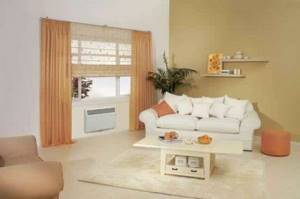
Most convector models operate completely silently. Only some devices may produce slight crackling or clicking noises during operation.
At the same time, the high cost of wasted electricity is to a certain extent offset by the use of a special economical mode, which is provided in many models, as well as by programming the device to turn off at certain hours.
We calculate energy costs
You can save money by installing one wide appliance under a large window instead of several compact ones.
Electric heating convectors for cottages, wall-mounted and economical, work as independent or auxiliary heating devices, differing in their power. Considering the compactness of most dachas, they have small dimensions. They are also characterized by an affordable price, since in most cases, the dacha does not need any design delights. However, for country houses with designer interiors, you can purchase any suitable convector type heaters.
Why is it beneficial to use convectors in a dacha? The following factors are taken into account:
- compactness - the same oil radiators are much larger in size but less efficient;
- silent operation – fan heaters heat just as efficiently, but they make a lot of noise;
- low cost - electric convectors for summer cottages are the simplest models, so they are characterized by an affordable price.
Based on this, electric heaters for summer cottages are the optimal solution for organizing autonomous heating.
As we have already said, country electric convectors can work as main or auxiliary equipment. Working as the main equipment, they ensure complete heating of the premises in accordance with the set temperature. If the house already has a heating system, then convector heaters can operate in auxiliary mode, for example, during severe winter cold.
A small electric heater will be a great help if you have small children: by installing it in the room where the child sleeps, you will create comfortable sleeping conditions. Convectors are also useful as auxiliary equipment in very freezing rooms where the main heating cannot cope.
Since the equipment runs on electricity, its costs will be high. They depend on the air temperature outside, on severe frosts, on the presence of effective insulation of the country house, as well as on the area of the heated premises. Electronic control contributes some of the savings - it provides more accurate temperature monitoring.
As you can see, the price for heating with electricity is the highest, but you do not need to install heating boilers and lay pipes.
Let's calculate the approximate costs of heating a small country house with an area of 20 square meters. m. To heat it, we will need a radiator with a capacity of 2 kW (taking into account that the house has good thermal insulation and triple glazed windows are installed in it). If the heating operates around the clock without turning off, the electricity consumption will be 1440 kW per month. This figure must be multiplied by the cost of one kilowatt in your region.
For example, if the cost of one kilowatt is about 4 rubles, then the cost of heating the house will be 5,760 rubles. Special rates often apply to dacha communities and rural areas. If this rural tariff is 3 rubles per kilowatt, monthly expenses will be 4,320 rubles. Since convectors are equipped with regulators, they will not work around the clock. If we assume that they work 12 hours a day (obeying the commands of the thermostat), then the monthly consumption will be 720 kW, or 2160 rubles at the rural tariff.
Do you only go to your dacha on weekends? Then heating costs will be even lower. They will grow only if frost protection is used, which maintains the temperature in the country house at +5 degrees.
What is convection and convector
Convection is the process of heat transfer due to the movement of heated air. A convector is a device that heats air and promotes its movement. There are convectors in which heating occurs due to the circulation of coolant, then they are part of water heating. But we will talk about electric convectors, which convert electricity into heat, and air flows carry this heat throughout the room.
According to the installation method, convector electric heaters are wall-mounted, floor-mounted, in-floor (built in below floor level), baseboard and universal (installed on legs that come included or hung on the wall).

Convection heating principle
It is impossible to say which form of electric heating convectors is better. All forms are developed taking into account thermodynamics (at least, normal companies do this this way), so you base your choice only on your own preferences and on which design fits best into the design of the room. No one forbids installing electric convectors of different types in one apartment, house, or even in a room. The main thing is that the wiring can withstand.
How does it work
The operating principle of the described device is based on the phenomenon of convection. From the physics course we know that cold air is heavier than warm air, it is located in the lower part of the room, heated air masses gradually rise upward
Due to such movements, the entire air space in the room is heated.
The convector operates according to a simple algorithm. At the bottom of this device there is a heating element (it is also called a heat exchanger). To increase the volume of air passed through, this part is made in the form of a radiator with several flat fins. The angle of their inclination regulates the direction of heated air flows. The heat exchanger is covered by a protective metal casing.
According to the energy carrier used, all convectors can be divided into the following types:
- Devices powered by electricity;
- Gas convectors;
- Mermen.
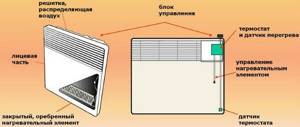
Convector heater device
At the top, as well as at the bottom of the convector body, there are several holes for sucking in cold air and transporting heated air. Structurally, it is made in such a way that the body of our device does not have direct contact with the heat sink, so the casing does not heat up and does not transfer heat. A similar transfer of heat resources occurs in water and oil radiators.
In everyday life, electric type convectors are mainly used. Water appliances have lower efficiency indicators; they differ from analogues in their significant overall dimensions, so they are installed in places where traditional water radiators are installed in niches under windows. Gas equipment, despite the possibility of saving energy resources, for some reason is not popular among consumers.
All models of the heaters under consideration, regardless of type, may have different overall dimensions. Some of them are equipped with built-in sensors and many additional functions. The main advantages of convectors are:
- Quiet operation. This characteristic is due to the absence of a fan in the device that hums;
- Possibility of installing the device on various surfaces (on the floor or wall, there are models that can even be installed on a windowsill);
- Beautiful design that will allow the installation to “fit” into any interior;
- Low heating temperature of the case, on average 60 degrees, maximum parameters - 90 degrees;
- Large models have wheels for easy movement around the room; lightweight devices can be mounted on the wall;
- When heating a room with a convector, oxygen is not burned;
- Devices can be left unattended;
- Long-term operation. Many manufacturers provide a 10-year warranty on the product.
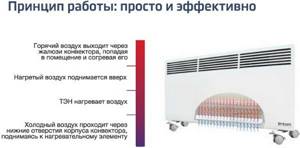
Operating principle of the convector
Despite the huge number of advantages, convectors also have negative qualities.
The disadvantages of such devices include:
- Low noise level when warming up;
- Impossibility of replacing the heating element at home;
- The absence of a fan affects the rate at which the room warms up.
Calculation
Having decided to carry out all the repair work yourself, you need to independently design the heating system and calculate it.
However, you need to follow certain instructions:
In order to correctly calculate the required power of the heating system for a country house, it is necessary to take into account all possible factors. First of all, you need to pay attention to the climatic zone in which the house is located
Next, it is important to calculate how much power the heat energy source has, and also understand what the volume of heat loss is. It is worth considering the volume of rooms that will be heated and their area. Next, you should calculate the required number of radiators to be installed, as well as their size. This includes the insulation of all enclosing structures. When the required amount of heat is determined for each room, you can select the type of heating devices, as well as begin their calculations. The easiest way to carry out calculations concerns electric heating elements, the electrical power of which is almost equal to thermal energy.
- It is necessary to calculate the installation of radiators so that the temperature in the living room and kitchen is at least 18 degrees, in the sleeping areas - up to 22 degrees, and in the children's room - up to 24 degrees.
- For each installed radiator, a harness is required. That is why all sections are placed very tightly in order to save pipeline fittings.
- The simplest solution to the calculation is to divide the number of batteries for the room by the number of window openings in it. However, it will not always be enough to install radiators under the window sills; in addition, you can install some heating devices in places of rest or work. The heating system must cover all heat losses in the house; in addition, there must also be a reserve of up to 25 percent. The reserve is made to ensure that the heating does not wear out; it is used only in emergency situations.

- The work of calculating gas boilers is the most difficult part of the project. After all, this is not only the correct selection of the required power, but also the competent organization of the removal of combustible products. To be able to regulate the draft speed, experts recommend installing automatic dampers, as well as smoke exhaust fans. If there are residual heat, they can be collected using an economizer, which is connected to the return current circuit. But the intake of combustion air can be done from the street, and not in the boiler room.
- A heating system operating on a liquid heat exchanger also has its own characteristics. Here you need to design a level pipeline routing diagram. In this case, it is imperative to determine the general state of the system’s displacement. It is also worth compensating for the expansion of the coolant by making an expansion tank. Then you need to determine the desired circulation speed.
- The room must have a window. Its area is calculated by multiplying the volume of the boiler room itself by a factor of 0.003. It will not only provide natural light, but also protect against explosion in the event of a gas leak. For the same purpose, the doors to the boiler room are placed so that they can only be opened outward.
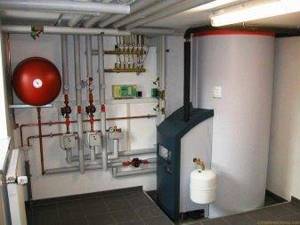
- The architectural part of the project includes not only the construction of a boiler room, but also the calculation and selection of a chimney. To correctly calculate the power of the equipment, it is necessary to take into account not only the diameter of the chimney, but also the volume of the pipes. First you need to do all the computational work. You don’t need any special knowledge for this; just use a calculator.
- The boiler room should not be less than fifteen cubic meters, and the height of the room should not be less than two and a half meters. It is also necessary to provide access to the boiler. The walls must be fire-resistant, that is, made of brick or concrete. If you build them from other materials, you need to apply a special coating to their surface, for example, asbestos.
- Also, in such a room there must be supply and exhaust ventilation. For every ten kilowatts of boiler power there must be a window with an area of ten square centimeters. The diameter of the chimney pipe must be no less than the opening of the boiler itself.
